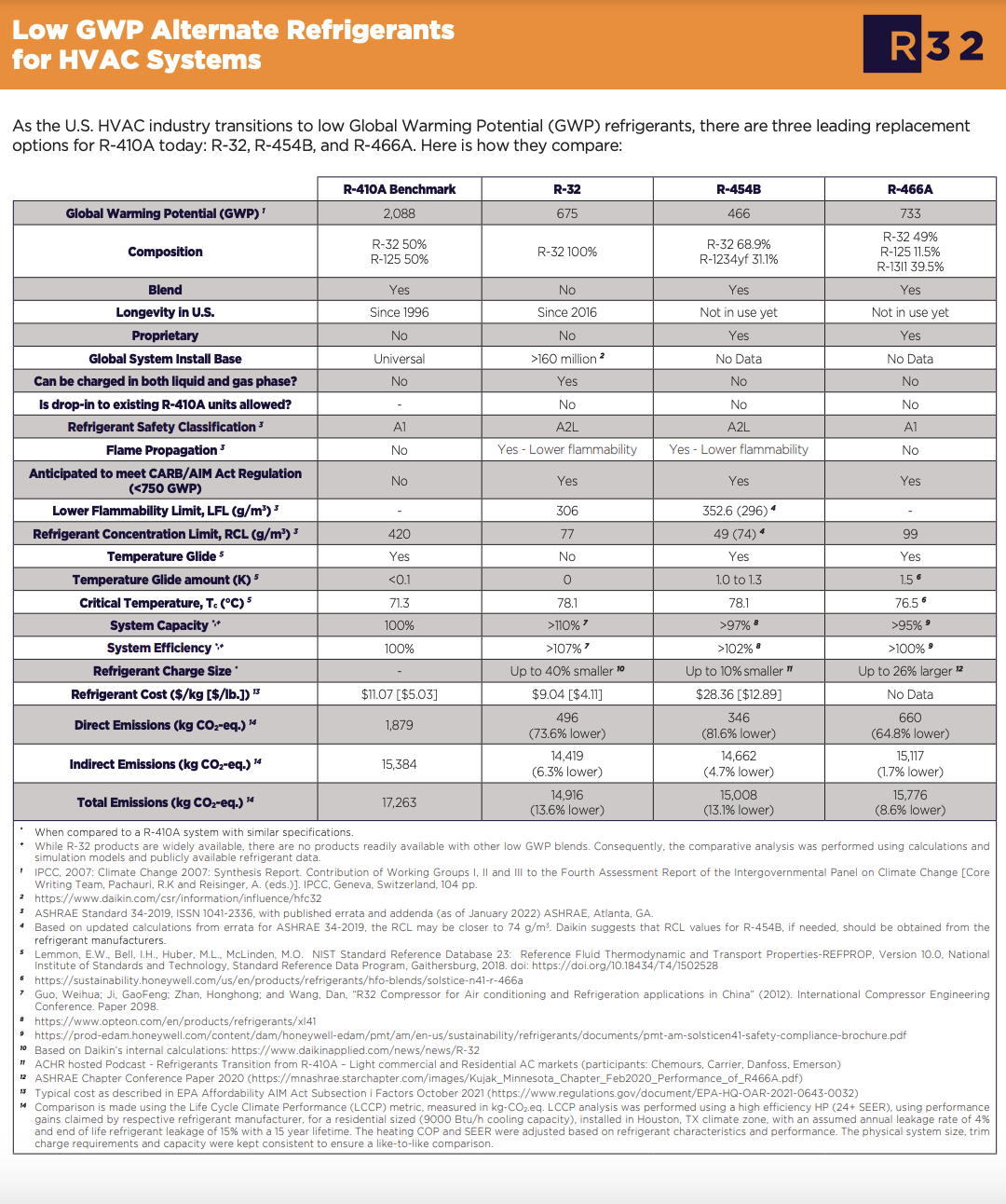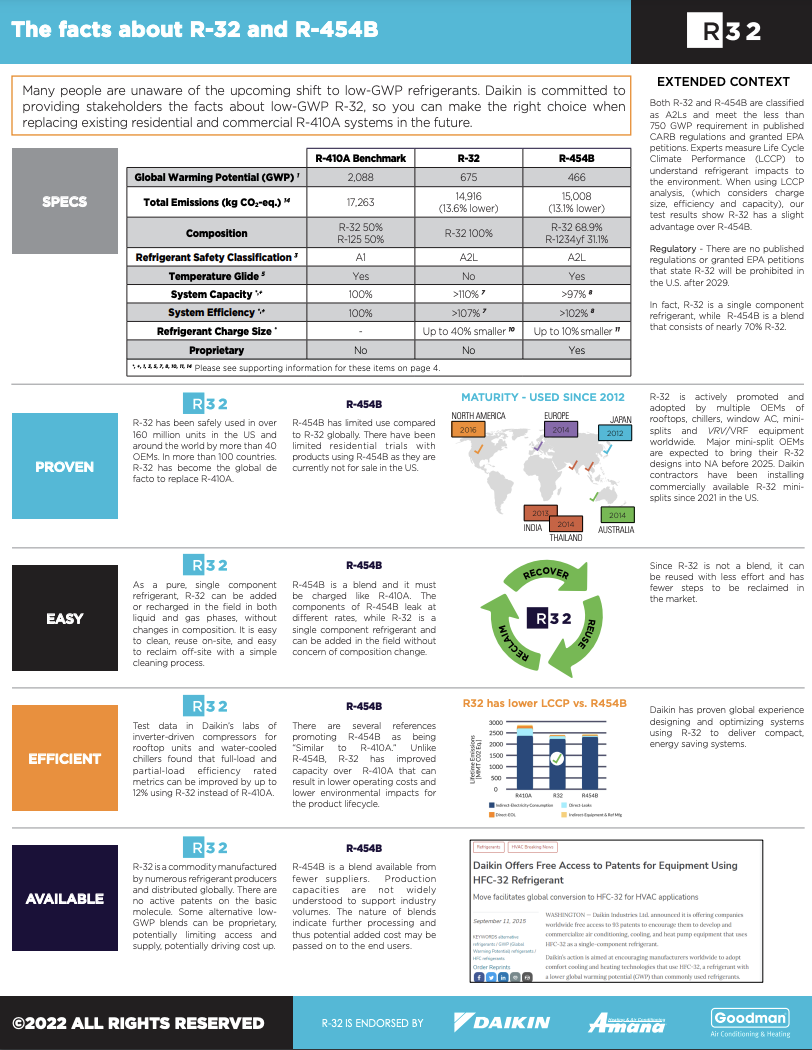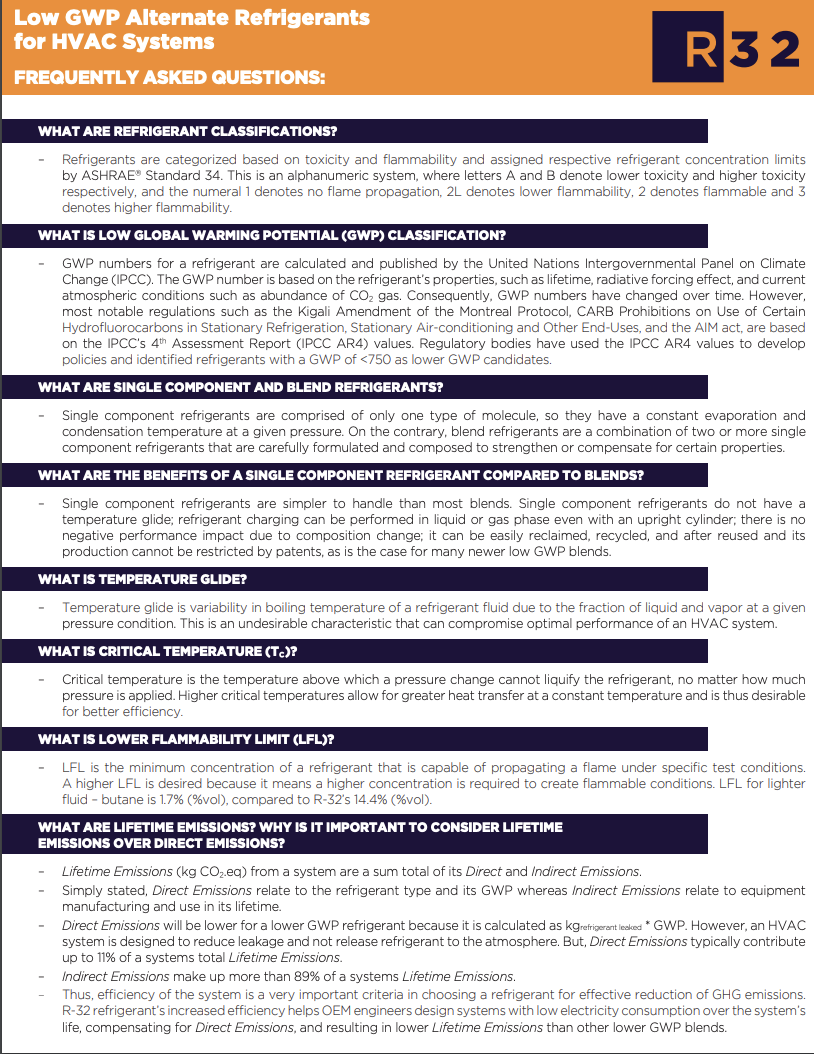When it comes to choosing the right refrigerant for your HVAC system, it's crucial to weigh the pros and cons of each option. At Houston Smart Air, we prioritize providing our clients with the best solutions for efficiency, performance, and environmental responsibility. Today, we're diving into a comparison between two popular refrigerants: R32 and R454. Spoiler alert: R32 takes the crown for most applications, and here's why.
1. Energy Efficiency: Why R32 Stands Out
Energy efficiency is a top priority for anyone looking to reduce operational costs and environmental impact. R32 shines in this area, offering excellent energy efficiency that allows HVAC systems to operate more effectively. This means lower energy consumption and reduced utility bills—a win-win for both your wallet and the planet.
On the other hand, while R454 refrigerants are also designed to be efficient, they generally don't match the superior energy performance of R32. Over time, this difference in efficiency can lead to significant savings, making R32 the smarter, more cost-effective choice.
2. Environmental Impact: R32’s Green Credentials
With growing concerns about climate change, choosing a refrigerant with a low Global Warming Potential (GWP) is essential. R32 has a GWP of 675, which is a significant improvement over older refrigerants like R410A. Additionally, R32 has zero Ozone Depletion Potential (ODP), making it an environmentally responsible option.
While R454 blends, such as R454B, do offer a lower GWP (often below 500), the slight environmental advantage they provide doesn’t outweigh the overall benefits of R32—especially when you consider R32’s superior energy efficiency.
3. Performance and Operating Pressure: R32 Leads the Way
R32 operates at higher pressures, which translates to better performance in HVAC systems. Systems designed for R32 can leverage these higher pressures to deliver improved cooling capacity and efficiency, making it the preferred choice for those looking to optimize their system’s performance.
R454 refrigerants, by contrast, operate at lower pressures. While this might make them easier to manage in some existing systems, they don’t provide the same level of performance as R32, especially in new installations designed to take full advantage of R32’s capabilities.
4. Safety and Flammability: R32 is a Safe Bet
Safety is always a concern when dealing with refrigerants, and R32 offers a solid balance between performance and safety. Classified as an A2L refrigerant, R32 has low toxicity and mild flammability, making it a safe choice for modern HVAC systems. While it does require careful handling, its safety profile is well within acceptable industry standards.
R454 refrigerants also fall into the A2L category, with similar flammability characteristics. However, the presence of R1234yf in R454 blends may slightly alter their safety characteristics, making R32 the more straightforward option.
5. Availability and Cost: R32 is the Practical Choice
R32 is widely available and has become the industry standard for many new HVAC installations. Its broad acceptance and cost-effectiveness make it an accessible choice for most consumers. Whether you’re installing a new system or upgrading an existing one, R32 is readily available and won’t break the bank.
In contrast, R454 refrigerants are newer to the market and may not be as readily available. They also tend to come with a higher price tag, which could be a consideration for budget-conscious customers.
6. Global Adoption: R32's Proven Track Record
Yet another point to be made is that R32 is currently being used in millions of equipment worldwide, whereas 454 is newly introduced and primarily being used in America, with much less equipment currently running on it. This extensive global adoption of R32 not only highlights its reliability and performance but also provides peace of mind to customers choosing a refrigerant with a proven track record.
Conclusion: R32 is the Clear Winner
At Houston Smart Air, we believe that R32 is the best refrigerant choice for most HVAC applications. Its superior energy efficiency, excellent performance, and solid environmental credentials make it the clear winner. While R454 refrigerants are a viable option for those solely focused on minimizing GWP, they don’t offer the same well-rounded benefits that R32 provides.
If you’re looking to upgrade your HVAC system or install a new one, R32 should be at the top of your list. It delivers the best balance of efficiency, performance, and environmental responsibility—exactly what you need to keep your home comfortable and your conscience clear.
For more information on how R32 can benefit your specific needs, or to explore our range of HVAC solutions, feel free to contact us at Houston Smart Air. We’re here to help you make the best choice for your home or business.
Additional Considerations When Choosing Between R32 and R454B Refrigerants
To provide a deeper understanding of the differences between R32 and R454B refrigerants, let’s explore additional key factors that can influence your decision.
System Compatibility and Retrofitting
When upgrading or replacing HVAC systems, compatibility with existing setups is crucial. R454B is often marketed as a direct replacement for R410A, making it an ideal choice for retrofitting older systems. Since it shares similar operating pressures and characteristics with R410A, switching to R454B typically requires fewer modifications, saving time and money.
In contrast, R32 has different properties, including higher operating pressures. While it is an excellent choice for new systems designed for its use, retrofitting existing systems to accommodate R32 may involve significant adjustments, such as reinforcing system components to handle the higher pressure. For homeowners or businesses considering upgrades, understanding these requirements is essential to avoid unexpected expenses and installation challenges.
Key Takeaway: If retrofitting an existing system, R454B might be more cost-effective, while R32 is better suited for new installations designed for its properties.
Maintenance and Handling Requirements
The composition of a refrigerant impacts its maintenance needs. R32, being a single-component refrigerant, offers simpler maintenance. Technicians can recharge systems with R32 without worrying about maintaining the proper blend ratios. This simplicity can reduce long-term maintenance costs and minimize the risk of errors during servicing.
R454B, on the other hand, is a blended refrigerant. Like R410A, it must be handled carefully during maintenance to ensure the blend remains balanced. If a leak occurs, the proportions of the components in R454B may shift, requiring a full system recharge rather than a simple top-up.
Additionally, both R32 and R454B are classified as mildly flammable (A2L), so proper training and safety protocols for handling these refrigerants are necessary.
Key Takeaway: R32’s single-component nature simplifies maintenance, while R454B requires careful handling to maintain its blend integrity.
Long-Term Availability and Regulatory Compliance
As environmental regulations become stricter, the refrigerant industry continues to adapt. Both R32 and R454B comply with current global warming potential (GWP) limits and are designed to meet evolving regulations. However, their future availability may differ.
R32, with its widespread adoption and established global supply chain, is expected to remain readily available for decades. Its relatively low GWP also makes it a safe bet for long-term regulatory compliance.
R454B is newer and designed as a direct alternative to R410A, which is being phased out due to its higher GWP. While R454B is gaining traction, its adoption rate and market support may not yet match R32, potentially affecting long-term availability.
Key Takeaway: R32’s established presence and lower GWP offer long-term reliability, while R454B is positioned as a transitional refrigerant for R410A systems.
Comprehensive Environmental Impact Metrics
Beyond GWP, evaluating refrigerants based on their Life Cycle Climate Performance (LCCP) provides a more complete picture of their environmental impact. LCCP accounts for not only direct emissions from refrigerant leaks but also indirect emissions related to energy efficiency during operation.
R32 generally has a slight edge in LCCP due to its high energy efficiency and smaller required charge size. This means systems using R32 typically consume less energy over their lifetime, resulting in fewer indirect emissions. R454B, while also efficient, may require a larger charge size to achieve similar cooling performance, which can increase its overall environmental footprint.
Key Takeaway: R32’s superior LCCP makes it a more environmentally sustainable choice in the long term.
Market Adoption and Manufacturer Support
The level of market adoption can significantly influence the ease of obtaining and maintaining refrigerants. R32 is a well-established refrigerant with a proven track record. It has been used in over 160 million units worldwide and is supported by more than 40 manufacturers. This widespread adoption ensures strong supply chains, extensive technician expertise, and easy availability of replacement parts.
R454B, while gaining traction, is relatively new. Although it is supported by several major manufacturers, its adoption rate and availability in some regions may still be limited compared to R32. For homeowners and businesses, choosing a refrigerant with strong market support can lead to better service and fewer challenges when sourcing components or technical expertise.
Key Takeaway: R32’s global adoption and robust manufacturer support make it a reliable choice, while R454B is still building its presence in the market.






